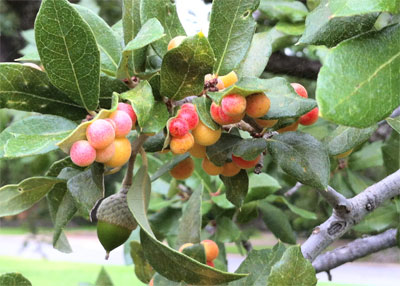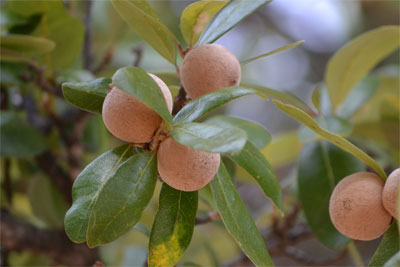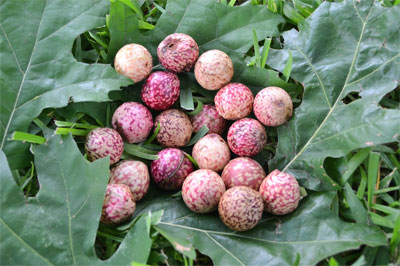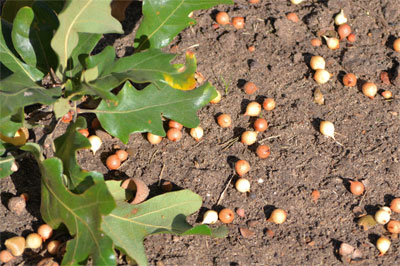Texas Tree Tips: Oak Galls

Colorful galls are quick to catch the attention of curious gardeners. All photos by Bill Seaman.
Oak Galls — “Curiouser and curiouser!”
Like Lewis Carroll’s character Alice, I too “quite forgot how to speak good English” when first researching the strange world of plant galls. The more I learned, the curiouser and curiouser I became! Instead of a lesson in horticulture, entomology, and plant physiology, learning the ins and outs of galls is akin to learning how to deliver Texas Tall Tales. Both have fascinating stories, but the part of the brain that houses logic keeps nagging, “Great story, but it can’t be true, can it?” This is the story gardeners need to know about oak gall.
In the simplest terms, galls are plant tissue growths resulting from exposure to minute amounts of hormone-like chemicals produced by the gall makers. The gall makers can be fungi, bacteria, nematodes, or mites — but insects are the primary culprits. Galls can occur on roots, flowers, bark or buds, but the galls on leaves and twigs are the most noticeable.

Mealy Oak Gall is commonly found on live oaks. The woody gall structure may remain attached to the twigs for years.
Texas gardeners are probably most familiar with the galls that appear on their oak trees. On live oaks, it is usually Mealy Oak Galls — those tan, jawbreaker-sized orbs that persist on the outer twigs long after the acorns drop. When they finally drop, they are woody, hard on bare feet, and on close inspection, have a single exit hole where the adult gall maker has gnawed its way out of its home.
Now this is where the truth begins to sound like a tale. With Mealy Oak Gall, the gall maker is a wasp. Entomologists call it a wasp, but gardeners associate wasps with yellow jackets and hornets. To us, wasp implies stingers. For gardeners, it might be more appropriate to think fruit fly, as the cynipid wasp is similar in size and sting to the fruit fly. That is a roundabout way of stating there is no sting.
Mother wasp finds an appropriate live oak twig to which she attaches her egg, and the chemicals on the egg induce the oak to grow a home for the soon-to-hatch grub. That is how Mealy Oak Galls are formed. The grub dines on the interior tissue of the gall until it matures and chews its way through the outer shell to be free to mate, lay more eggs — in the case of the females — and die. The gall structure is now vacant and can persist on the twig for a number of years as a curiosity, or drop to the ground, to the bane of fussy gardeners.
While there are as many different galls in oaks as there are cynipid wasps, the life cycles are similar. However, the life cycles can be much more complex than stated here. Some even include both a sexual and an asexual phase that I will leave to the entomologists to explain.
For most galls on oak trees, the insect is a species of cynipid wasp. And, strangely enough, each species of wasp is associated with a specific species of oak tree. Oak Apple Gall is commonly found on both Texas red oaks and Shumard red oaks. Unlike the Mealy Oak Gall, this lime-sized gall looks to be fragile, with a thin, translucent outer cover. It retains its spring-green color into summer, when it fades to a light brown. When the skin is peeled away, an interior structure of cotton-candy-like fibers is revealed.

Oak Plum Galls can be difficult to spot in the canopies of red oaks, but are easily seen when they drop to the lawns below.
Oak Plum Gall is also found on red oaks. These grape-sized galls are colored maroon and cream, and are easier spotted on the lawn as they begin to drop, than nestled in with the clusters of acorns in the trees. This gall could be mistaken for a tropical fruit, and if cut in half, reveals a dark red center with a single larva in the center.

Galls from a post oak clutter the ground as they detach from leaves and twigs in time to be covered with fall’s leaf litter.
I have found that the best way to manage oak galls is by pouring a large glass of ice tea, adding a squeeze of lemon and a sprig of mint, and finding a good book to read. While it is true that some galls are harmful, oak galls are not. The resources surrendered by the tree are negligible. Applying insecticides to manage the adult population at the time eggs are laid would require precise timing and would have a negative effect on beneficial insects. If you are concerned about the aesthetics, take some comfort in knowing that the gall makers tend to be cyclical. Some years bring heavy infestations while others bring none.
When you do find galls in your garden, take time to inspect them closely. You too, will become curiouser and curiouser.
